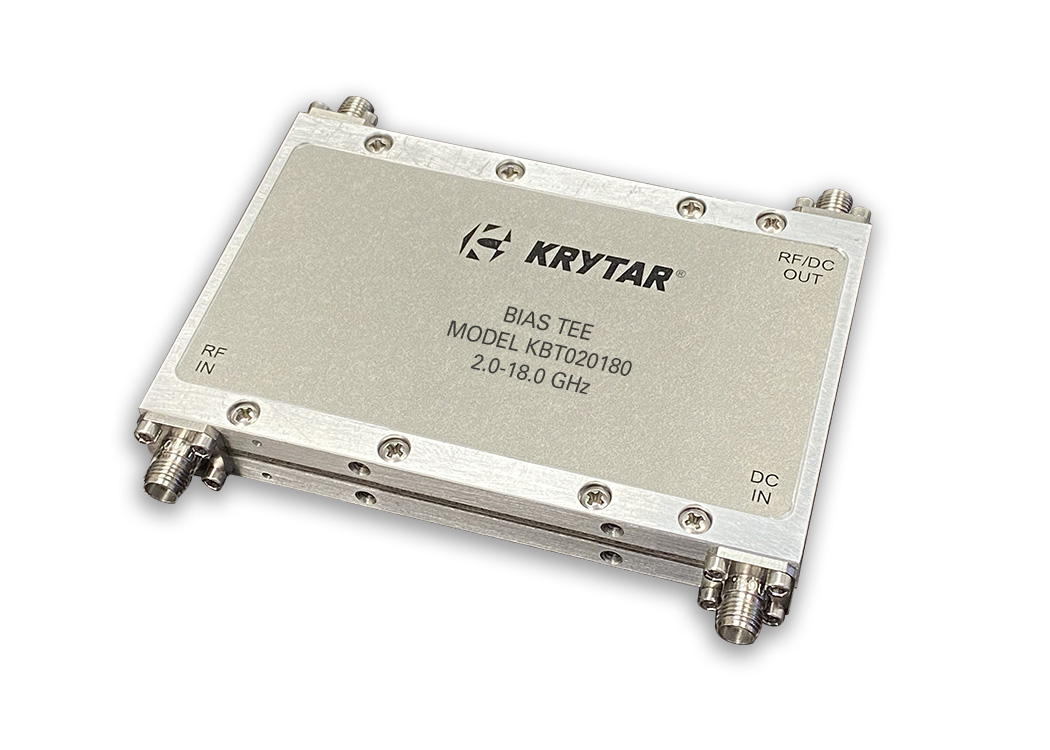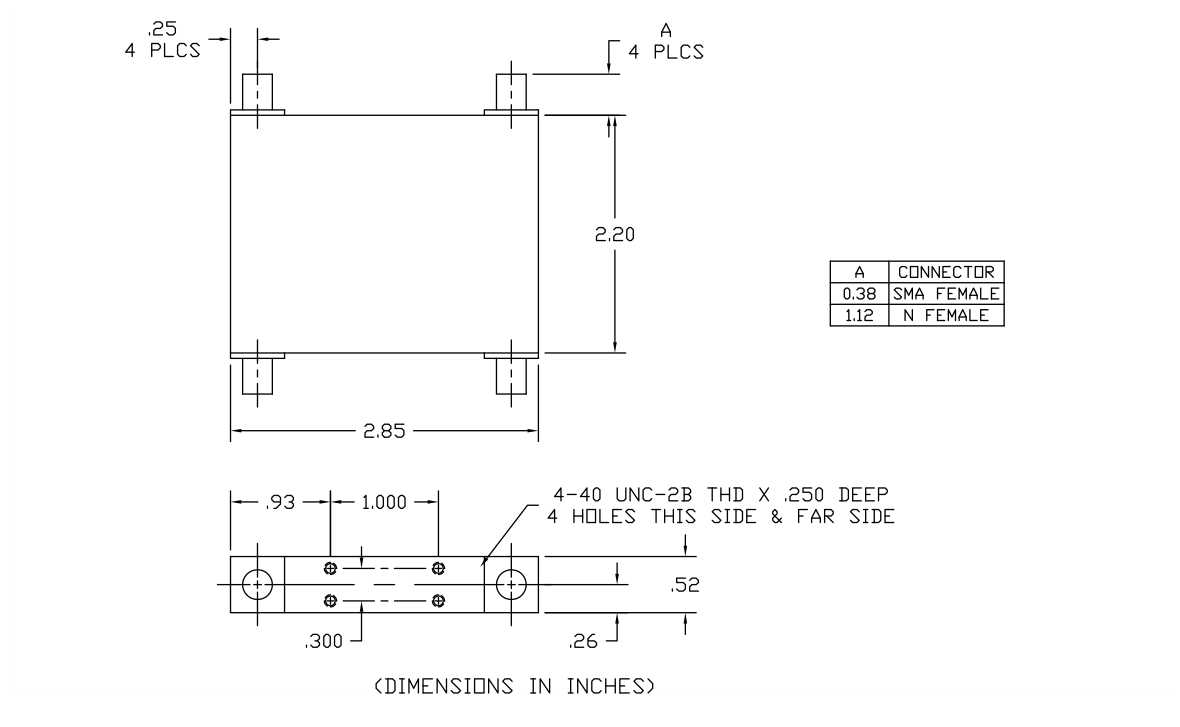Bias Tee KBT020180
SPECIFICATIONS
Model Number
Freq. Min. (GHz)
Freq. Max. (GHz)
FEATURES
2.0 – 18.0 GHz (S thru Ku-Bands)
High Current Handling
High Power at Frequency
Excellent Isolation
Superior Electrical Performance
Rugged Stripline Design
Product Description
KRYTAR has developed a line of Bias Tees offering ultra-broadband control solutions with coverage of multiple microwave bands, from 0.5 to 40 GHz. KRYTAR Bias Tees are the ideal choice for powering remote control of pre-amplifiers or low-noise amplifiers (LNAs) in antennas, controlling remote DC signals and testing of many RF applications. The unique rugged stripline design provides high current handling with high power at frequency and excellent isolation.
KRYTAR’s Bias Tee Model KBT020180 offers superior performance ratings including: Operating Frequency range from 2.0 to 18.0 GHz (S thru Ku-Bands); VSWR: 1.5, Insertion Loss <2.7 dB, Min., Isolation of 16 dB, Min., Power Rating is 20 Watts, DC Voltage is 50 Max., and DC Current is 1.5 Amps Max. Standard connectors are SMA Female (Optional N-Type) and Operating temperature is -54° to 85° C.
Properties that are important to a Bias Tee are RF bandwidth, insertion loss and mismatch at the two RF ports, the maximum DC current, and video bandwidth of the DC port. Connectorized Bias Tees are used in a variety of applications, but are generally used in the transmission line to send the DC and radio signals over the same coaxial cable that is being used to transmit RF signals. One of the prime applications of a RF and Microwave bias tee is to inject DC currents or voltages into RF and microwave circuits without affecting the RF signal passing through the main transmission line. This can be done in the lab for system-level testing. Bias Tees are also used to provide DC power, to power amplifiers mounted on the top a communications tower in close proximity to the antenna. A bias tee can also be used to combine the DC power with a AC/RF signal to provide power to other devices, connected to an antenna.
The critical key parameters for the selection of a bias tee are current and voltage requirements, size, cost and a reputable manufacturer in the RF/Microwave community. KRYTAR offers complete engineering services for custom designs that meet or exceed critical performance and/or packaging specifications.
Common Definitions
| Microwave Frequency Bands | |
| Band Designation | Frequency Range (GHz) |
| UHF | 300 MHz – 1.0 GHz |
| L | 1.0 – 2.0 |
| S | 2.0 – 4.0 |
| C | 4.0 – 8.0 |
| X | 8.0 – 12.0 |
| DBS | 12.2 – 12.7 |
| Ku | 12.0 – 18.0 |
| K | 18.0 – 26.5 |
| Ka | 26.5 – 40.0 |
| Q | 30.0 – 50.0 |
| U | 40.0 – 60.0 |
| V | 50.0 – 75.0 |
Gigahertz (GHz): A unit of measurement denoting the number of cycles in one second. One GHz is one billion cycles every second.
Megahertz (MHz): Equal to 1 million Hz. Uses the SI Prefix Mega, meaning 10^6.
VSWR (Voltage Standing Wave Ratio): The ratio of the maximum voltage to the minimum voltage in standing wave pattern along the length of a transmission line structure. It varies from 1 to (plus) infinity and is always positive. VSWR can be converted to return loss or the reflection coefficient.
Insertion Loss: In telecommunications, Insertion Loss is the loss of signal power resulting from the insertion of a device in a transmission line or optical fiber and is usually expressed in decibels, or dB.
Isolation: In telecommunications, Isolation refers to the ability to prevent a signal from appearing at a node in a circuit where it is unwanted and is expressed in decibels, or dB.
Operating Temperature: An operating temperature is the temperature at which an electrical device operates. The device will operate effectively within a specified temperature range which varies based on the device function and application context, and ranges from the minimum operating temperature to the maximum operating temperature (or peak operating temperature). Outside this range of safe operating temperatures the device may fail.
5G
The fifth generation (5G) of cellular service, superseding 4G LTE. Governed by the 3GPP, 5G will increase transmission speed dramatically and embrace prioritization. As wireless data increases exponentially, real-time content such as video calling and video streaming must be given a higher priority than data on Web pages.
5G NR (5G New Radio)
The 5G new radio access technology (RAT) air-interface is a global standard, which like 4G also uses OFDM modulation, and is designed to deliver data rates up to 20 Gbps, enabling individual users to get gigabit-per-second downloads over the air (OTA). Wireless virtual reality (VR) and augmented reality (AR) can become commonplace, and 5G is expected to provide a huge boost for connecting billions of Internet of Things (IoT) devices.
Wi-Fi 6
Wi-Fi 6 is the most recent iteration of the IEEE standard for wireless local-area network (WLAN) protocol and is a substantial upgrade over its predecessors Wi-Fi 4 and Wi-Fi 5. Wi-Fi 6 operates between 2.4 GHz and 5 GHz. Wi-Fi 6 can be significantly faster due to technologies like traffic prioritization, OFDMA, and beamforming.
Wi-Fi 6E
Wi-Fi 6E operates at 6 GHz (5.925–7.125 GHz in the U.S.) and also the 2.4 GHz or 5 GHz devices already in use. Wi-Fi 6E-enabled devices can take advantage of the newer 6 GHz frequency band for further improved connectivity.
Common Definitions
| Microwave Frequency Bands | |
| Band Designation | Frequency Range (GHz) |
| UHF | 300 MHz – 1.0 GHz |
| L | 1.0 – 2.0 |
| S | 2.0 – 4.0 |
| C | 4.0 – 8.0 |
| X | 8.0 – 12.0 |
| DBS | 12.2 – 12.7 |
| Ku | 12.0 – 18.0 |
| K | 18.0 – 26.5 |
| Ka | 26.5 – 40.0 |
| Q | 30.0 – 50.0 |
| U | 40.0 – 60.0 |
| V | 50.0 – 75.0 |
Gigahertz (GHz): A unit of measurement denoting the number of cycles in one second. One GHz is one billion cycles every second.
Megahertz (MHz): Equal to 1 million Hz. Uses the SI Prefix Mega, meaning 10^6.
VSWR (Voltage Standing Wave Ratio): The ratio of the maximum voltage to the minimum voltage in standing wave pattern along the length of a transmission line structure. It varies from 1 to (plus) infinity and is always positive. VSWR can be converted to return loss or the reflection coefficient.
Insertion Loss: In telecommunications, Insertion Loss is the loss of signal power resulting from the insertion of a device in a transmission line or optical fiber and is usually expressed in decibels, or dB.
Isolation: In telecommunications, Isolation refers to the ability to prevent a signal from appearing at a node in a circuit where it is unwanted and is expressed in decibels, or dB.
Operating Temperature: An operating temperature is the temperature at which an electrical device operates. The device will operate effectively within a specified temperature range which varies based on the device function and application context, and ranges from the minimum operating temperature to the maximum operating temperature (or peak operating temperature). Outside this range of safe operating temperatures the device may fail.
5G
The fifth generation (5G) of cellular service, superseding 4G LTE. Governed by the 3GPP, 5G will increase transmission speed dramatically and embrace prioritization. As wireless data increases exponentially, real-time content such as video calling and video streaming must be given a higher priority than data on Web pages.
5G NR (5G New Radio)
The 5G new radio access technology (RAT) air-interface is a global standard, which like 4G also uses OFDM modulation, and is designed to deliver data rates up to 20 Gbps, enabling individual users to get gigabit-per-second downloads over the air (OTA). Wireless virtual reality (VR) and augmented reality (AR) can become commonplace, and 5G is expected to provide a huge boost for connecting billions of Internet of Things (IoT) devices.
Wi-Fi 6
Wi-Fi 6 is the most recent iteration of the IEEE standard for wireless local-area network (WLAN) protocol and is a substantial upgrade over its predecessors Wi-Fi 4 and Wi-Fi 5. Wi-Fi 6 operates between 2.4 GHz and 5 GHz. Wi-Fi 6 can be significantly faster due to technologies like traffic prioritization, OFDMA, and beamforming.
Wi-Fi 6E
Wi-Fi 6E operates at 6 GHz (5.925–7.125 GHz in the U.S.) and also the 2.4 GHz or 5 GHz devices already in use. Wi-Fi 6E-enabled devices can take advantage of the newer 6 GHz frequency band for further improved connectivity.



